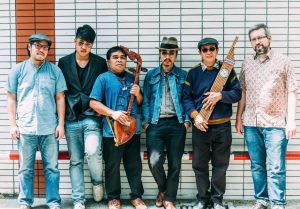Straight Outta Isan: The Rising Re-emergence of Thailand’s Country Music
The first time I heard luk thung was also the first time I learned about the thinly veiled prejudice against it. “What is this music?” I asked my teenage cousin. “Just some pleng baan nork, what do you care?” he replied dismissively, not looking up from his comic book. As an 8-year-old, I didn’t quite grasp what he meant by that. Sure, I’d heard kids at school calling those from Isan, the northeast of Thailand, “baan nork” before, and it was about as endearing as calling someone a peasant. So, naturally, I was not prepared to hear it used to describe something as pleasant as music, let alone witness the unlikely rise of these “baan nork” sounds in years to come.
My cousin’s opinion speaks volumes about how Bangkokians in general regard this particular genre of music. Sung in Isan dialect, luk thung (literally “children of the field”) and its counterpart molam deal with the joys and struggles of the rural life—the very things the Thai middle class don’t necessarily relate to. Luk thung and molam are what you typically hear blasting from a public bus or a somtum (papaya salad—a northeastern specialty) stall, although less so in an Uber or an upscale shopping mall.
But like any great story, there’s a satisfying irony to be revelled in. Since the breakout success of 1995’s TV series Monrak Luk Thung (“the spellbinding power of luk thung”), many pop has-beens have adopted this rural sonic aesthetic hoping that, by reaching out to the more provincial market, their career would be resuscitated. While some triumphed, many crashed and burned, including British-Thai singer Katreeya English and girl group Jamp. The spirit of luk thung, not unlike that of hip-hop, has to be lived, not adopted as part of a marketing ploy.
This ethos obviously struck a chord with local DJ Maft Sai, whose deep appreciation for the so-called “baan nork” sounds led him to host a monthly shindig soundtracked by luk thung and molam gems from the ’60s and ’70s. Held between 2009-2014 at various venues around the city, these parties proved a hit among expats and the indie crowd. The once marginalized sound suddenly became hip and sought after. He, along with crate-digging accomplice Chris Menist, eventually opened a record store and later formed The Paradise Bangkok Molam International Band, a six-piece collective hell-bent on spreading the luk thung and molam love to the world (and, judging from the success of their recent European tour, they’re pretty good at it).

Paradise Bangkok
Maft Sai and his crew may have paved the way over the years, but it was Isan-born, Chiang Mai-based chanteuse Rasmee Wayrana who took things further in 2016. Drawing inspiration from soul legends like Nina Simone and Billie Holiday as well as Afrobeat grandmaster Fela Kuti, she laces the sound of rice paddies with a global appeal, re-contextualizing luk thung and molam like no one has done before.
Rasmee is not alone in this. Today, more and more young independent artists are exploring fresh, new possibilities for this ever-humble genre. Bands like Isanjah are fusing elements of stoner reggae with iconic Isan instruments like the phin lute and traditional bamboo mouth organ called khaen, while Tontrakul serves up a thrilling amalgam of indie rock, drum ’n’ bass and Isan music.

Isanjah (image via YouTube)
Having found an unlikely ally in non-mainstream musicians, these exciting hybrids are now a mainstay on indie Internet radio Cat Radio and music streaming site Fungjai. No longer a lesser form of entertainment nor a last resort for unwitting, washed-up pop stars, “pleng baan nork” has given rise to today’s most exciting sounds in Thai music.
Check out this playlist on Spotify for more luk thung.



